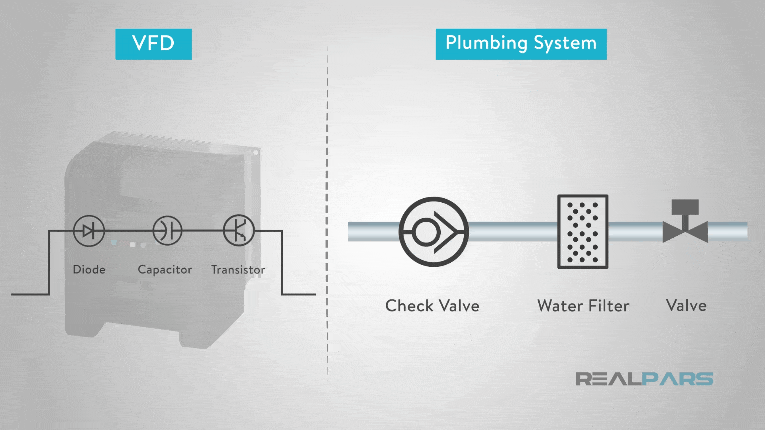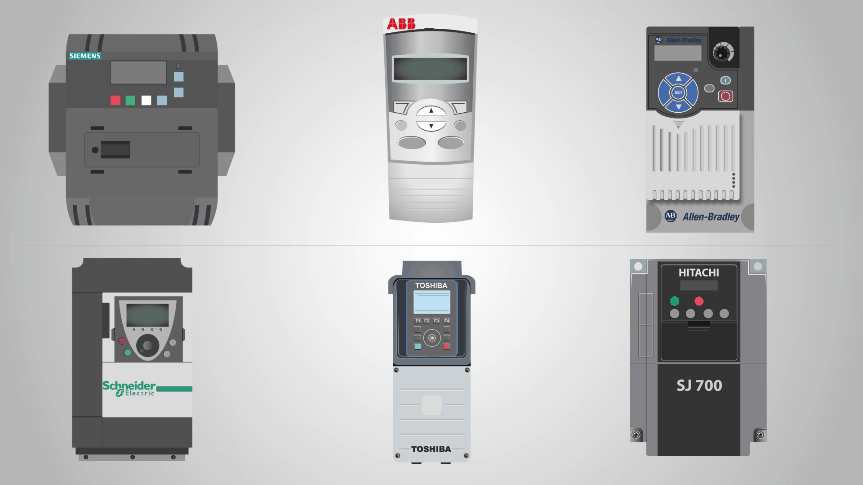What is a VFD?


Today you will learn about VFD. Specifically, what a VFD is and when do we use it with automation and PLCs.
So what exactly is a VFD? Well, it stands for Variable Frequency Drive.
They are used for running an AC motor at variable speeds or let them ramp up their speed to give them a smooth startup.
Some people simply call them drives.
VFDs work by adjusting the frequency of the motor to adjust the rpms.
To do this, a VFD will actually convert the voltage twice:
1) First, it converts our three-phase AC to DC. This is accomplished with diodes.
2) Then it cleans the DC with a capacitor.
3) Next, it will convert the DC to AC. This is accomplished with transistors acting as switches.
Utilizing these “switches” is what allows the VFD to adjust the frequency that the VFD supplies to the motor. This, in turn, controls the speed of the motor.

Now I know this is a lot of information to take in. Let me compare the internal workings of the VFD with a simple plumbing system.
First, let’s look at the diodes that convert the AC to DC. This operates like a check valve in a water system.
A check valve, like a diode with electricity, only allows water to flow in one direction.
The capacitor acts as a water filter to keep everything clean and useable.
The transistors act like valves. They turn the flow on and off when needed. This allows the VFD to adjust the frequency to the motor.

Now that we have an understanding of how a VFD works, let’s see what they are used for.
One very common use in industry is to control the speed of a water pump in a water treatment facility.
A water treatment plant typically has a constant flow of water coming in to the plant. However, if the water demand exiting the plant is lower than the supply entering the plant, then the operator will need to slow down the supply.This is achieved by using a VFD on the AC motor.
The operator can monitor water flow and manually adjust the VFD accordingly.
Another great thing about VFDs is the fact that they can be controlled with a PLC. Using basic communication protocols that have been covered in previous videos, such as RS232 and RS485, PLCs can monitor and control motor speeds using the VFD.
This helps make a process like water treatment that much easier and more efficient. This setup can be used in any situation that would benefit from automation.

Let’s look back at what we now know. VFD stands for Variable Frequency Drive. They are used for controlling the speed of an AC motor.
They are also used for ramping up a motor for a smooth startup, or to prevent a heavy load from straining the motor on startup.
This is accomplished by adjusting the frequency delivered to the motor. A setup of an AC to DC converter, then DC to AC converter.
Variable Frequency Drives are used throughout industry. A common example is to regulate water flow entering a water treatment plant. VFDs allow the operator to control the flow of the pump manually or automatically with a PLC.
There are many different brands and features available. If you are looking at using a VFD just be sure to do your research!

I hope this blog post has helped you get a feel for VFDs. They really can make any automation or industrial process operate more smoothly.
As always, be sure to check back soon for more RealPars videos and blog posts!
Thanks for reading and sharing our blog posts with your friends and colleagues.
The RealPars Team
Learn from
Industry Experts
With a 7-day trial, then €25/month


